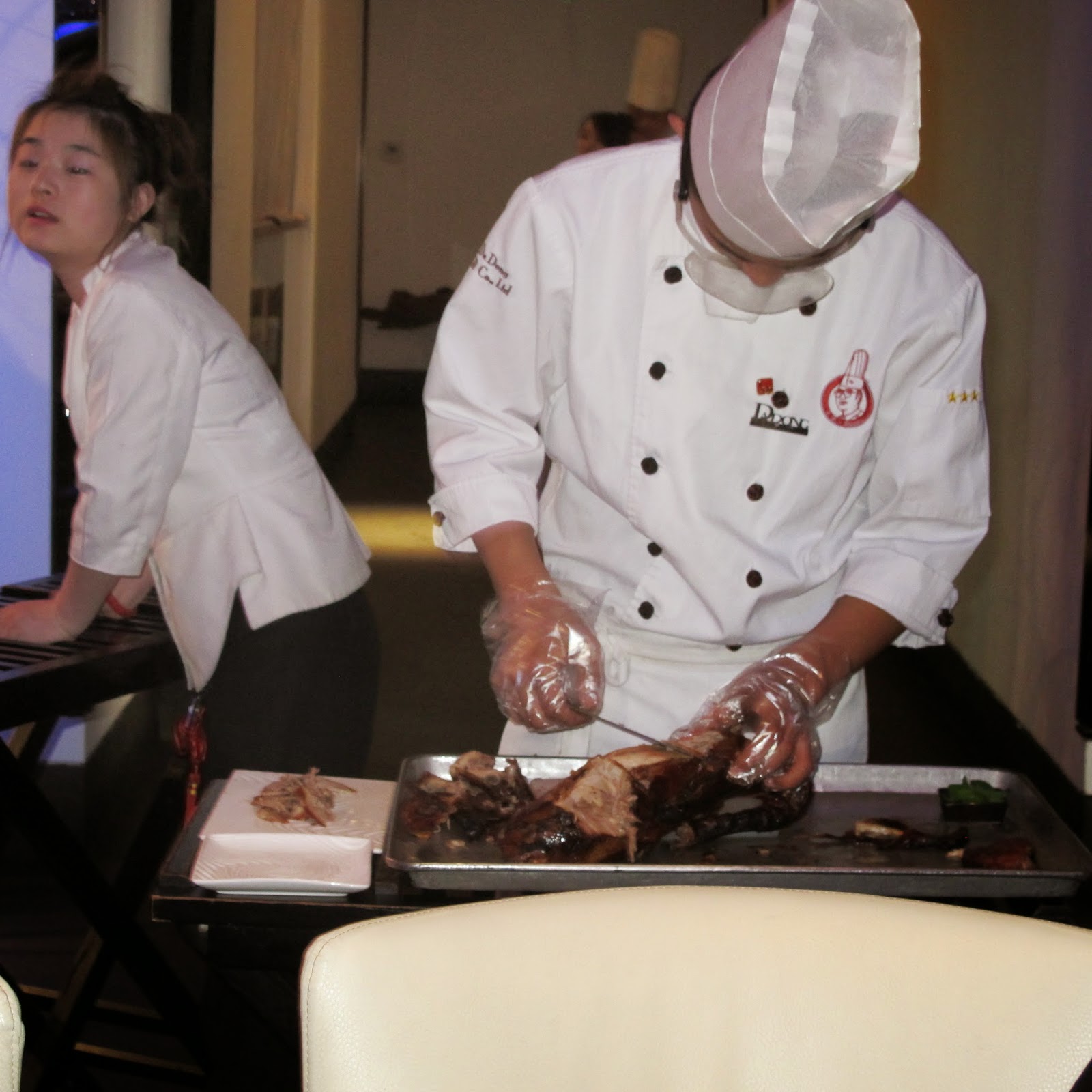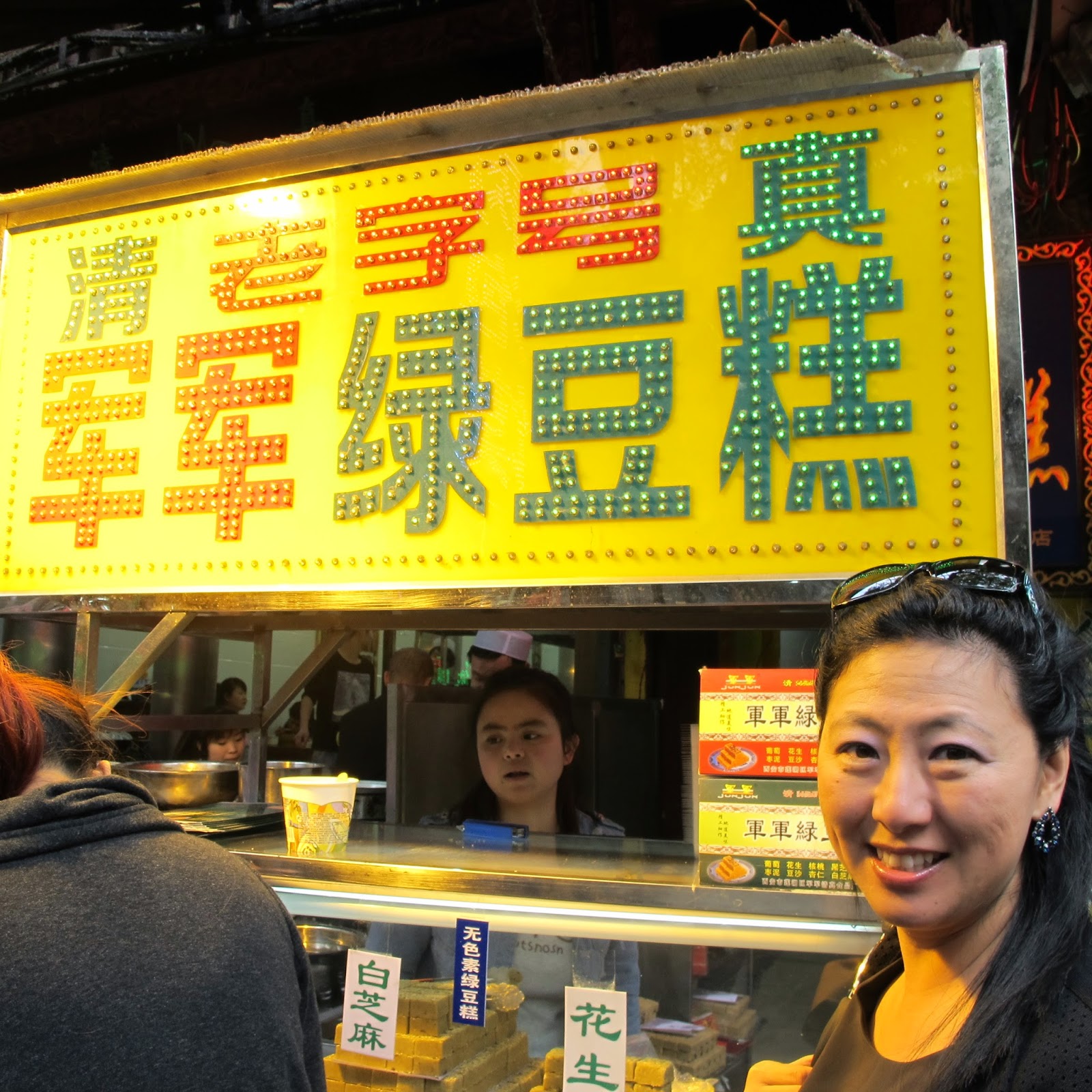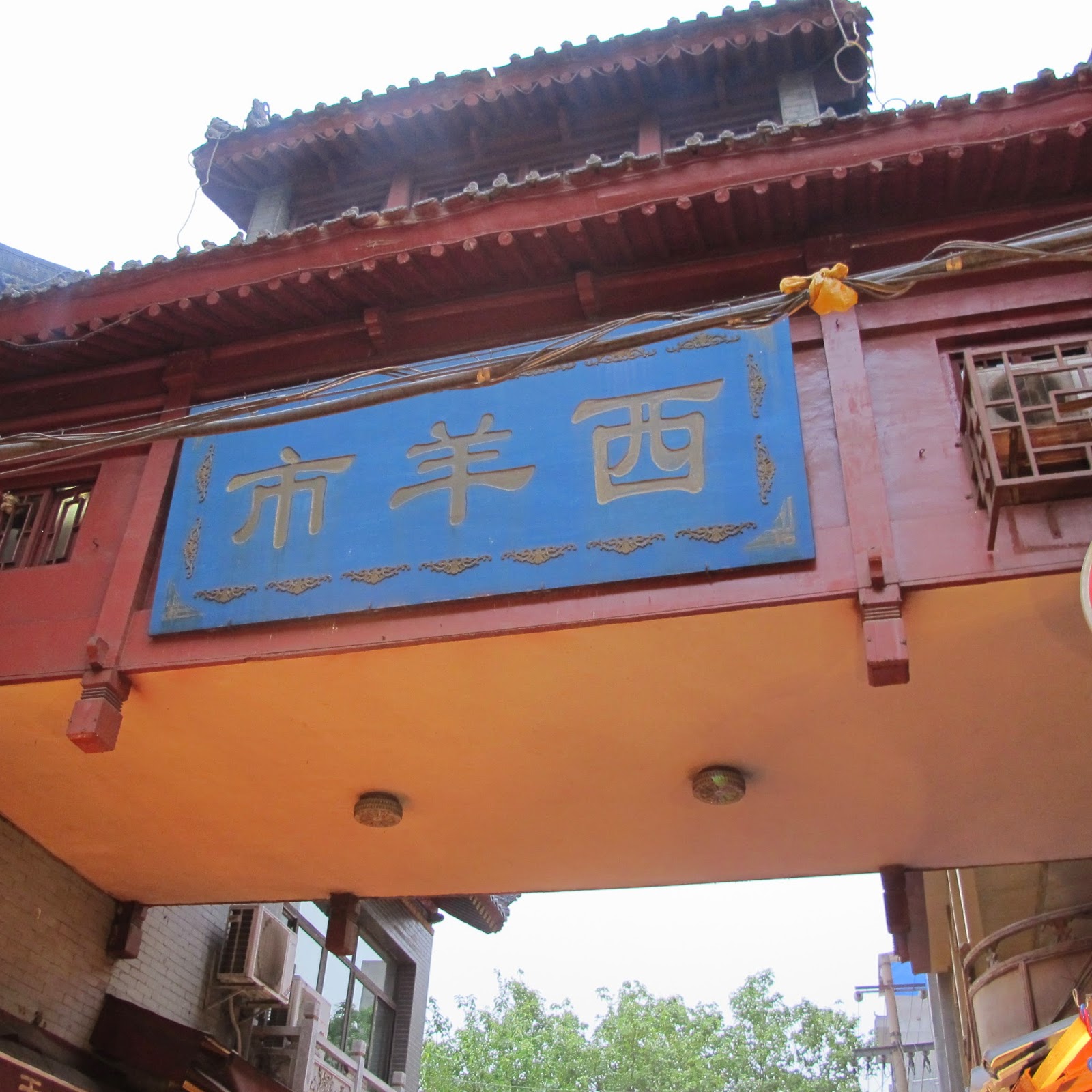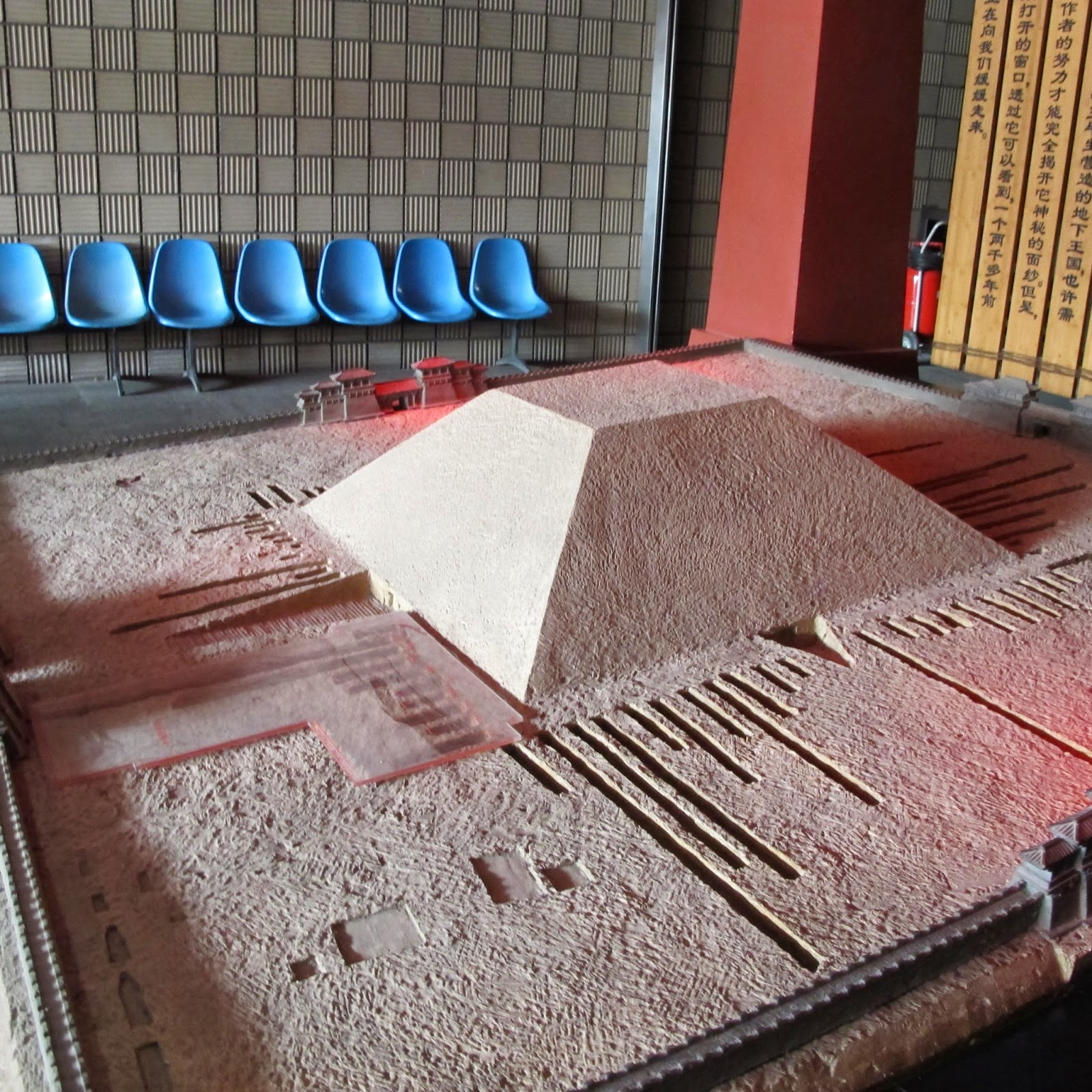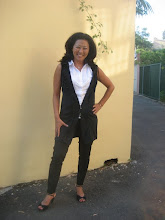Two "Greats" completed, only one more to go! (Video)
More than that, while I'd been to Shanghai and both Hong Kong and Taiwan, I still had not been to the capitol of China. Shanghai epitomized "shopping" for me so I was keen to visit Beijing for the more historic and cultural aspects.
Fri. April 18
I departed on Air China on April 17 at 8 p.m. to arrive on April 18 at 6 a.m. in the morning. After checking into the Novotel Peace Beijing, I walked around the city for miles! I had a map but wasn't paying too much attention to it, mostly wandering aimlessly and following the crowds.
First I walked along a street lined with department stores (Wangfujing Dajie Street), then it turned down this lane of street food.
I meandered to the outside walls of the Forbidden City and essentially walked all around it.
Video April 18:
The more important the religious building the more deities (see the animals on the eaves of the roof). This one has 11 animal deities.
These beautiful tulips are in Zhongshan Park which is between the Forbidden City and the Gates of Heavenly Peace.
I had to go through security to get to this point, then another security check point to get to Tian' anmen Square.
Similar to the Japanese Department stores, the upper most level is the Restaurant Level. The Movement 2nd Restaurant I had dinner at had this system where you checked the boxes on the menu, then press a buzzer when you were ready for the menu to be picked up.
Sat. April 19 - Beijing Full Day City Tour
Visit the heart of Beijing, Tiananmen Square, which was built on Mao Zedong's orders and is the world's largest public square holding over 1 million people during military parades and again in 1976 following Mao's death. From Tiananmen Square, we headed to the impressive Gate of Heavenly Peace under the famous portrait of Mao to visit the Forbidden City. This is China's largest and best-preserved cluster of ancient buildings where the Emperor's lived.
The below is a complete solid piece of rock that scales the side of this temple in the Forbidden City. It's the longest stone carving at 16.75 meters. It has waves at the bottom and 9 dragons which are an imperial symbol. It was brought here by springing water on the cold ground so that it was turned to ice, making it easier to bring here from the Western Suburbs of Beijing.
Visit the Temple of Heaven, China's finest example of Ming architecture and a building that has come to symbolize Beijing. It's situated on 267 acres of Tiantan Park which is considered sacred ground where Emperors performed major ceremonial rites.
I purchased kites for my nieces and nephews and this photo reminds me of how simple "toys" can be great outdoor, enjoyable activities.
Then I visited the Summer Palace, the world's largest Imperial garden where I enjoyed a cruise on Kunming Lake.
April 19 Slide Show:
April 19 Video:
Sun. April 20
This was a free day, so I spent the morning at the National Museum of China where I had afternoon tea before taking a closer look around Tian' anmen Square. Then I took public transport (train) to Beihei North to check out Three Stone Kite Shop. After a quick trip back to the hotel to drop off the kites I purchases, I picked up my tickets to see the Chinese Acrobats Show.
These are ancient Chinese coins, isn't it interesting how they started in the shape of blades and spades?
There was a section of the National Museum of China devoted to all the gifts that leaders from around the world had given to China. Frankly, some of these gifts were over-the-top and frankly nothing I would even consider placing in my home.
Entry to the National Museum of China required not only going through the security x-ray, but also a full bodied search with a wand.
Here I am in Tian'anmen Square
There's high security in Tian'anmen Square (your bag's checked and you go through a security x-ray, they also look at your passport/ID). Some of it's visible with uniformed cops, some is undercover. There's been occasion in the past when protesters have light themselves on fire so as a result there's a number of fire hydrants around for easy access. My tour guide also informed me not to hold a water bottle over my head, as it's a sure way to get tackled by the police.
This store was highly recommended for its kites.
Here I am with the owner of Three Stone Kites.
In the evening I enjoyed a Chinese Acrobatic Show.
April 20 Video:
April 20 Slide show:
Mon. April 21 - Hutongs Bell and Drum Tower Half Day Tour
We started by a stroll in Yandai Bai which is a small shopping village.
Then we headed to the Drum Tower (the Bell Tower is unvisitable) where we waited for half an hour for the drum demonstration to take place at 10:30 a.m.
My tour guide climbing the stairs to the top of the Drum Tower.
This is the Bell Tower, but it's unaccessible to the public. On my last night I had drinks at a roof top pub which had views of the Bell Tower.
We explored the ancient backstreets of Beijing's hutongs (villages) by rickshaw which took me to a local family home where I had a simple lunch inside.
Near the Beihei Park, we walked to and visited Prince Kung's Mansion.
The number of bolts on the doors have some significance, the doors to the Gates of Heaven also had a special number of bolts.
I was thrilled to have dinner with my Cisco Beijing colleagues at a famous Peking Duck Restaurant called Beijing Dadong Roast Duck Restaurant. Thank you so much to Sophy, Vivian, Mary and Chunbo for your wonderful company and the most AMAZING meal!
I LOVED these frozen water chestnuts, Sophy was so kind and arranged a take-away box for me to take back to the hotel with me to enjoy later on...
April 21 Slideshow:
April 21 Video:
Tues. April 22
This was another free day (no pre-arranged tours) so my plan was to visit Beihai Park which was once reserved only for emperors such as the Mongol emperor Kublai Khan. It's dominated by a large lake, dotted with temples and a 1,000-year-long history.
The Jade Inlet has a 36m high White Dagoba which was originally constructed in 1741 in anticipation of the Dalai Lama's visit.
After a audio-recording self-guided tour of Beihai Park, I walked North to:
- A funky historic shopping district (hutong) called "Nanluogu Xiang" for some shopping (Plastered 8)
- A afternoon snack at Wen Yu's Custard Shop which was recommended for its milk custard which was so yummy that if I had another free day I would go back just for another.
- Dinner at Yaoji Chaogan, a true local's restaurant, serving local food in a no-nonsense atmosphere - It was a darn good thing that a compassionate lady working the register helped me navigate the complex system of picking up the dishes I ordered from the various stations.
- An after dinner drink at late night bar, Drum and Bell, located in between the Drum and Bell Towers and has a great roof-top terrace with views of the Bell Tower.
This is the view of the Forbidden City that I enjoyed from up here on this tower where I sat for about 45 minutes finishing my postcards.
This is the famous screen of the nine-dragons (on each side) plus hundreds more on the decorative tiling for a total of 635 dragons.
On a recommendation from my tour guide, I had lunch here after a visit to Beihai Park.
The dish I ordered was a "paper" version of gingham-yaki which is traditionally cooked over fire in aluminum.
Here's the famous Wen Yu's Custard Shop - I was lucky they still had custards as once they run out that's it! For those that know me, it'll be of no surprise that I chose the custard with the red azuki bean.
This is Plastered 8 which takes propaganda posters from a hundred years ago and puts them on t-shirts. I wanted to buy t-shirts for my nephew and sister-in-law so chose the two below. Believe me there were many more designs that just would not have sent the right message - like the one below of a cartoon panda shooting a gun. It's cute, but again now one I'd endorse giving as a souvenir gift for my young nephew.
With the help of the guide book, I ordered the steamed pork dumplings, the local's favorite douzhi (soy milk soup) and Beijing's best-known noodle dish called zhajiang main.
Another benefit of eating at Yaoji Chaogan, a local's restaurant, is the price. My total dinner was 17 Yuan which translates to US$2.77. I have to say this has to rank as my cheapest meal ever! And there was so much, I couldn't even eat it all! I enjoyed the noodle dish and the dumplings but even though I love soy beans/tofu I didn't rate the douzhi (soy milk soup) as it was way too sour.
There was no English menu or sign to the restaurant, so I feel quite proud for finding the restaurant in the first place.
I had a great cosmopolitan cocktail at the Drum & Bell.
April 22 Slideshow:
April 22 Video:
Wed. April 23 - Visit to the Great Wall of China at Mutianyu Day Tour
Built over 2,000 years ago during the Qin Dynasty (221-207BC), it stretches 5,000 km from the Shangaiguan Pass on the east coast to the Gobi Desert in the west. It ironically didn't meet its purpose of repelling Genghis Khan's invaders from the north.
I travelled 90 km northeast of Beijing to Mutianyu, a less crowded section of the Wall that is considered one of the most spectacular sections with numerous guard towers and amazing views. The Mutianyu section dates back to the Ming Dynasty and was built upon an earlier Northern Qi Dynasty conception.
I took the cable car up which was very scenic and a toboggan sled down. I must admit that in light of the Great Wall of China being a top historic attraction and one of the few identifiable views from outer space, it was a bit surprising that "Disneyland" commercialism has extended to the Great Wall in the form of a toboggan sled ride as a means of traversing down from the Great Wall of China back to base camp.
Here's a map of the section of the Great Wall that I'm visiting.
I'm enjoying the view from the cable car ride up to the Great Wall of China.
This is one of the towers that are along the Great Wall.
The stairs, in some sections, are very steep!
The historic architecture locales I've visited over the past few years (Machu Picchu and City of Pompei) have consistently thought about water drainage. Here's the water drainage solution on the Great Wall of China.
I don't know why people feel they need to leave their "mark" (graffiti) on historic locations. Here's a "solution" to people's need to leave their name and message. I didn't partake in this.
This hazy image reminds me of the view I had of Machu Picchu on my arrival there when the clouds covered the site.
Instead of taking the cable car down, I took a toboggan! So not what I expected at this historic landmark!
Upon arrival back at the base, I purchase a little "globe" of the Great Wall and this lady wrote my Japanese middle name on the inside.
Upon returning back in the city, I saw this retelling of this tale of a boy who joins a monastery and becomes a strong, monk trained in the martial arts.
For dinner, we went to this Chinese Hot Pot restaurant.
On the walk back to my hotel I found this souvenir that I'd been looking high and low for my basketball crazy nephew Kai. It's a jersey from the Chinese Basketball Association (CBA). While I don't follow basketball very closely, even I know of Yao Ming who's one of the first to make it big in the NBA. The Beijing Ducks won the 2013-2014 season of the Chinese Basketball Association. Before playing in the NBA, Yao Ming played for the CBA's Shanghai-based basketball team called the Shanghai Sharks.
April 23 Slideshow:
April 23 Video:
Thurs. April 24
I had a 12:25 p.m. flight that departed Beijing and arrived in Xian at 2:25 p.m. where upon arrival I checked into the Sofitel Xian on Renmin Square where I was lucky to get upgraded to a very nice suite. Later that evening I went to this place famous for its gyoza dumplings and music and dancing performance.
Papa has a secret "Horiuchi recipe" for gyoza and on several occasions he's made gyoza for family and friends (and many times had us help in the preparation of folding the gyoza). Of course, loving daughter that I am, I believe that nobody makes better tasting gyoza than Papa!
Now I still stand by that, however, when it comes to the shape of gyoza - I will say there's a potential new trend here!
The three-pocket gyoza with different vegetables is quite clever.
Can you tell this is a gold fish with a fancy tail and green peas for eyes?
And this basket had gyoza that was the shape of animals and vegetables (down to the color, shape and taste of the vegetable it represented). See the green cabbage and the purple eggplant?
And this one is an origami swan.
I think this is meant to be a bear.
And this one, I'm not quite sure, but it's got seeds as eyes. Maybe an owl?
Watch the video to hear the horn he's playing. While the instrument looks like the mountains where the dragon lives in Lord of the Rings, the sound is very light and entertaining.
This piece tells the story of the famous painting it represents, three women each with a different natural element - a bird, tree and ? (I don't remember).
On the way back to my hotel we passed by the ancient city surrounded by a wall, it looks beautiful all lit up!
April 24 Video:
Fri. April 25- Tombs and Warriors Full Day Tour
On the way to the Terracotta Warrior site, we checked out a Banpo Village where an excavation has revealed items that date back to the Neolithic era (6,000 years ago). Historians have pieced together a world akin to that of our ancestors and what was on view was what archealogical remains.
On the way to the Terracotta Warriors, we stopped off at a place where they make the souvenir warriors. There are really only a handful of different types of "figures" they make and it's based on the different types of figures found in the ancient burial - standing archer, kneeling archer, horse, warrior, officer, general - and they come in all sizes (including life-size) in the event you'd like to put one in your garden or protecting your front gate.
Then I visited the world famous Army of Terracotta Warriors, one of the most important archaeological discoveries of the 20th century. These 8,000 life-size terra-cotta warriors and horses were only unearthed in 1974 after being buried for 2,000 years. They were created to protect the Emperor Qin Shi Huang in the afterlife. Each figure is unique to both facial features and general expressions and hair.
Friends that have been to see the Terracotta Warriors have been super impressed which is why I made a separate trip to Xian to see them. I went expecting to be most impressed with the thousands of Terracotta Warriors standing in line at this archeological site. However, after learning the history, what was even more impressive was how after an "insurrection army" destroyed the burial site by burning it and smashing all of the Warriors, archeologists were like Humpty Dumpty, able to put the Terracotta Warriors back together again. It's like the most difficult puzzle ever - over time the color disappeared and as they were smashed and burned all the pieces are buried and as the warriors were standing close together the pieces became indistinguishable.
About 8 farmers were digging a well back in 1974 when they stumbled upon the pieces of the Terracotta Warriors ... and that's how this burial site was discovered. They estimate 8,000 Terracotta Warriors were placed in this burial site, but on my visit only about 1,000 were put back together again. The first pit I visited (Pit #1) had the most standing in formation. The second pit (Pit #3) had the "General's headquarters" and was the most complete (it's the one with the four horses). The third pit (Pit #2) had the "standing and kneeling archers" and was the least complete. So, if in 40 years the architects were able to reconstruct 1,000 warriors, can you imagine how many more years it'll take to fully excavate all 8,000 warriors?
Can you imagine how hard it is to start from this and turn it into a completely repaired warrior?
This is an imprint of a wheel. As the horse carriages are made out of wood, they didn't withstand the many hundreds of years.

This photo shows that at one time each of these warriors was a brightly colored figure!
This pit is the smallest but also the most complete.
This is the heel of the kneeling archer's shoe. Can you see the incredible detail! And imagine that this level of detail was present on each of the "kneeling archers" in the terra-cotta army?!
And this shows the detail of the hair braid of the warrior.
And you can not only see the detail on the armor but some of the red color remaining and that's preserved inside of this glass case.
These are some of the weapons that the warriors held.
In some cases, they only dug so far - established that this is a kneeling archer - and then moved on to other areas of the pit. Leaving this warrior half "revealed".
Back in 1974, seven farmers were digging to build a well when they stumbled upon this burial site. One of the 4 farmers still alive today was signing books in the gift shop. Here's a photo of me with one of the farmers and the picture book I purchased for Papa.
There were tremendous crowds at the terra cotta warriors, can you see them all peering at the warriors lined up and facing where the crowds are standing.
Here's one of the stations where they're putting the warrior back together - can you see it's missing some pieces?
The pieces are sorted into boxes before they're assembled.
After I got back to my hotel, I walked to a restaurant my tour guide recommended. I was unable to find it, but did stumble upon another "drum tower" (akin to the drum and bell towers in Beijing) that I checked out before heading to dinner. On the way, I walked passed this park where I heard these large, fire-cracker sounds. Upon closer examination, it turned out to be people taking what looked like whips to slap or hit the spinning top to keep it turning. I asked my guide about this the next day and she said it's an activity geared to senior citizens as it keeps their reflexes and coordination sharp and is a form of light exercise. I was tempted to get this for Papa, but could never find it in the shops.
This is the Bell Tower all light up.
In the underground tunnel on the way to the Bell Tower, I found China's version of the $1 store. It's the 10 Yuan Store!
From the Bell Tower you can look across to see the Drum Tower... after my visit to Beijing, this is my second "Bell and Drum Tower" pair I've visited.
I went into the Bell Tower and the red color was quite brilliant!
This Bell Tower has 10 little animals on the roof, meaning it's a highly religious building.
April 25 Slide Show Part 1;
April 25 Slide Show Part 2:
April 25 Video Part 1:
April 25 Video Part 2:
April 25 Video Part 3:
First time I heard these "firecracker" tops
Sat. April 26 - Xian Full Day City Tour
Xian is one of China's ancient capitals rich in royal and religious historic sites. I skipped the visit to the Shaanxi Provincial Museum (it was too crowded and the guide and I would have had to wait in line instead of cutting the que). I explored the grounds of the Big Goose Pagoda which dates back to the 7th Century and was built to house the first Buddhist scriptures brought to China from India.
I visited the ancient city walls which stretch 14 km around the site of old Xian. I bicycled around it in about 2 hours and really had to pedal hard for the last half hour to return the bike in time.
The Grand Mosque is an interesting fusion of Chinese and Islamic architectural elements. With all of its followers drawn to this area of the city it soon became known as the Muslim Quarter.
The Muslim Quarter is fascinating and one of the liveliest old quarters of any Chinese City. It has vibrant street markets and original street food that I've never seen anywhere else all along its narrow cobbled lanes.
So much food is consumed here! Lots of shish-kabobs!
I loved this rice cake, I had one slice and if I wasn't so full would have eaten another!
I had this square of cake - I think it was made of almonds and I chose one kind from those various flavors - but I found it very dry and unflavorful.
There are dried figs and walnuts everywhere. I ordered a bag of the figs, but they tasted like they were old and spoiled. Yet, I suspect I was comparing it to the Japanese dried figs that are coated in sugar.
Here's some chicken... which I didn't eat, but it made for an interesting photo of TONS of meat.
This is mirror cake with rose jelly and it was very sugary sweet, which of course suited me fine! They call it "mirror cake" because it's served on a stick, like a hand mirror.
This Chinese character, I suspect it is made up, has many, many strokes but it does make for an interesting gimmick to draw people to this restaurant. It's pronounced "byan byan" and is a think white noodle soup.
This gentleman served me and was also the one featured in a travel clip featuring this famous noodle shop in the Muslim Quarter. That's my beef noodle soup. I must admit that I'd eaten so much food along the streets that I could barely finish the bowl of very think white noodles!
The most expensive bowl of noodles is 50 Yuan which is like US$8. I think that my bowl was on the less expensive side...
This is the gate near the entrance of the Muslim Quarter.
After the tour guide dropped me back off at the hotel, I rested a bit then walked back to the Muslim Quarter to check it out at a more leisurely pace on my own. Oh and of course for dinner!
Lots of people were standing around waiting for this dessert. Check out the video, it looks like milk yogurt put into a metal bowl frozen with dry ice, then the frozen chips are scooped into a cup and then you put different flavors of jelly inside. I got mine with red azuki beans stirred in... yum!
April 26 Slideshow:
April 26 Video Part 1:
April 26 Video Part 2:
April 26 Video Part 3
April 26 Video Part 4 - A very aggressive top spinner, maybe he's working out a frustration?
Sun. April 27
On the way to the airport, I visited the Han Yangling Tombs which are for Emperor Jingdi the 4th Emperor and his Empress Wang of the Han Dynasty. These tombs are a interesting contrast to the Qin Dynasty Warriors as the figures are small (read as not life size, more the size of dolls) and more a reflection on daily life (farm animals). The site also allows you to view the tombs from above through glass floors which gives you another perspective on the size of the pits and how deep the pits are.
I'm standing looking down into the tombs through the glass floor.
Each of these figures was dressed in colorful cloth robes, but over time they disintegrated. So today, all that remains are the armless figures.
This is a model of what the tombs might have looked like... with the figures dressed in cloth robes.
Here's another model of what the robing might have looked like.
Here I am in front of the museum.
April 27 Slide Show
April 27 Video

















































